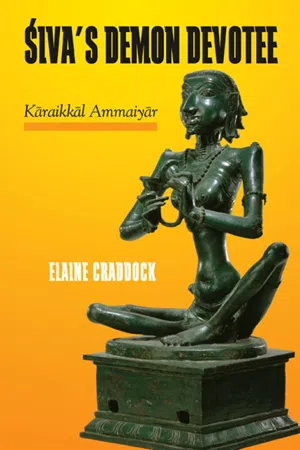![]()
1
The Place of Kāraikkāl Ammaiyār in South Indian History
Kāraikkāl Ammaiyār's poetry bridges the classical Tamil world and the devotional milieu in which Sanskritic myths are localized in a Tamil landscape and infused with Tamil modes of relating to the divine. Although Ammaiyār does not directly praise the Tamil land or Tamil language as the later Śaiva poets do, her poetry is animated by literary and cultural elements that are defining features of the classical Tamil world. Ammaiyār makes reference to many of Śiva's heroic deeds as related in Sanskrit myths and epics, but she is especially devoted to Śiva dancing in the cremation ground, a scenario that resonates profoundly with Tamil ideas of death and dessicated wastelands. In order to understand how Ammaiyār's poetry situates Śiva in the Tamil landscape, in this chapter I present a brief historical overview of the milieu in which Kāraikkāl Ammaiyār composed her poetry, including the literary traditions that inform her work.
A vivid portrait of life in Tamilnadu in the early centuries of the Common Era emerges from the earliest surviving Tamil literature, which was likely composed or compiled between the first century BCE and the fifth century CE. Literature can convey certain social and cultural facts, but since it “refracts as much as it reflects,” it is necessary to “enter the realm of the symbolic values that writers express through the ‘facts’ and ‘objective entities’” (Ramanujan 1999a, 52). In classical Tamil literature human behavior and natural landscape are key components of a poetic system that reflects and structures the values and aesthetics of the Tamil world during the centuries leading up to the beginnings of devotional Hinduism. By outlining a chronological development of cultural and literary ideas and practices in Tamilnadu, I aim to convey the complex environment that Richard Davis describes as the “shared religious culture where divine figures, literary tropes, and ritual forms could all be reincorporated, reformulated, and resituated for polemical purposes” (Davis 1999, 218).
This early literature consists of the first Tamil work on grammar and poetics, the Tolkāppiyam; ten long poems by ten different poets called the Pattuppāţţu; and eight anthologies (E₪₪utokai) of poetry that is divided into two types: akam, “inner” or love poems; and puŗam, “outer” or public poems about kings, war, heroism, death, codes of conduct, and so on. These poems were composed by Pulavaṉs, “wise men.” Although the poems are clearly rooted in an oral culture, they are syntactically too complex to have been simply extemporized, and may have been composed in writing; A. K. Ramanujan calls the poems “witnesses to a transition” (1985, 273). The Brāhmī script, which was probably the first script used for Tamil, was introduced into Tamilnadu in approximately the second or third century BCE. From ancient times two forms of Tamil seem to have been in use: a spoken form with many dialects, and a written, standardized language. Several centuries after the texts' composition, this classical literature was labeled “Caṅkam” literature, referring to three caчkams or academies of poets that, according to legend, each met for thousands of years in ancient kingdoms in or near the city of Maturai that were subsequently washed away by floods. In addition is the Tirukkuŗaľ, traditionally attributed to Tiruvaḷḷuvar and probably composed 450–550 CE, a compendium of aphoristic verses about ethics, virtue, love, politics, and economic issues that continues to be esteemed in Tamil culture.1 The Tirukkuŗaľ delineates the social and moral milieu in which Ammaiyār composes her poetry, but it is the akam and puŗam poetry that Ammaiyār draws on to give voice to her uncompromising love of Śiva and her conviction that he is the divine hero who conquers evil and through whom the devotee can conquer death. The varied scenes of love and heroism in the classical poetry become the stages of devotion to Śiva and the arenas of his heroic activities.
In the Tolkāppiyam the akam and puŗam poems are characterized by tiʼnai, which is most often translated as “landscape” or “poetic situation.” But Martha Ann Selby suggests these words are inadequate to convey the scope and boundary of this concept. She says, “Tiʼnai is, in a very real sense, the artistic space circumscribed by the poets, along with everything contained therein. I tentatively choose the word ‘context’ to translated tiʼnai, but what must be understood is that this context includes geographical space, time, and everything that grows, develops, and lives within that space and time, including emotion” (2000, 33). There are seven tiʼnai or contexts for akam and for puŗam poems; each of the five major or “middle” contexts is assigned to a geographical landscape that contains characteristic flowers, birds, animals, people, drums, and gods; each landscape is connected to a particular season, time of day, and subcategory or theme (tuŗai); and finally, each context has a fixed behavior, mood, or emotion that on one level defines the context. The behavior or mood of each akam poem is a phase in the love relationship between a man and a woman. The five main akam contexts, named after a flower or plant found in each landscape, are: mountain (kuŗiħci), first union; pasture (mullai), waiting for a lover to return; countryside (marutam), infidelity and resentment; seashore (neytal), lamenting the lover's absence; and wasteland (pālai), separation. Many of Kāraikkāl Ammaiyār's poems take place in a pālai landscape. The last two situations in akam poetry are not related to a particular landscape and are not the subject of true love poetry, which is well-matched or proper love. These situations are mismatched love (peruntiʼnai), and unrequited love (kaikkiľai). The characters in akam poetry are not named, but are restricted to a few anonymous, conventional types: the hero and heroine, the heroine's foster-mother, friends and messengers, the concubine...
